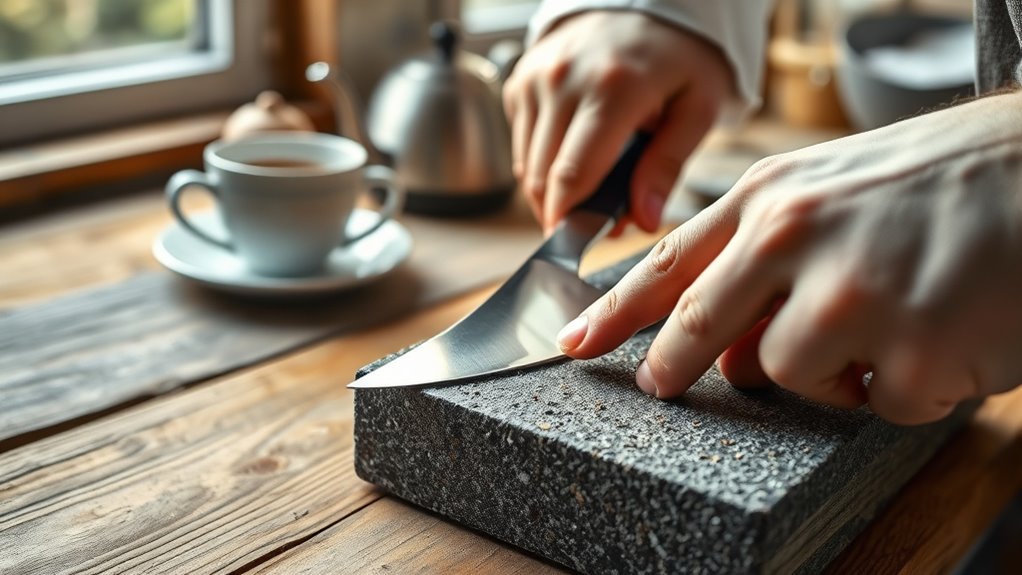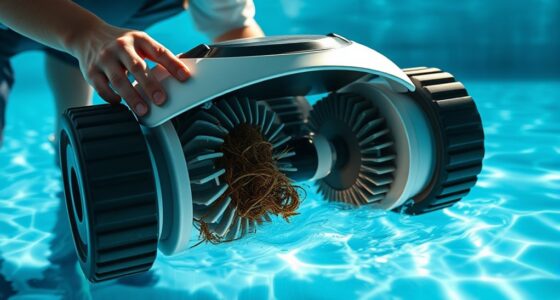To sharpen knives effectively, you need to understand the right angle (usually 15-20°) and use the proper tools like sharpening stones and honing rods. Focus on maintaining a consistent angle and gently working across the entire edge. Regular honing and careful storage extend your blade’s life, ensuring safety and efficiency. If you keep these basics in mind, you’ll become confident in keeping your knives sharp—stay with us to master the full process.
Key Takeaways
- Consistently maintain a 15-20° angle for optimal sharpening and sharper, durable edges.
- Use appropriate grit stones and lubricants to achieve a smoother, more effective sharpening process.
- Alternate sides evenly during sharpening to prevent uneven blade wear and ensure balanced edge.
- Regular honing with a rod helps maintain sharpness between sharpening sessions.
- Proper storage and immediate cleaning after use prolong blade sharpness and prevent damage.
Understanding the Basics of Knife Sharpness

Understanding the basics of knife sharpness is essential because a sharp knife makes cutting safer and more efficient. The key lies in the edge angles, which determine how sharp your blade can get. A smaller angle, typically between 15-20 degrees, creates a sharper edge but may be more delicate. Proper honing techniques help maintain this sharpness by realigning the edge regularly, preventing dullness. When honing, you gently slide the blade along a honing steel at the correct angle, ensuring the edge stays true. Knowing the right edge angles for your knife and practicing consistent honing techniques keeps your blade sharp longer. Additionally, understanding knife edge angles can help you make informed decisions about sharpening tools and techniques. This understanding forms the foundation for effective sharpening, making your kitchen tasks easier and safer.
Essential Tools for Beginners: What You Need to Get Started
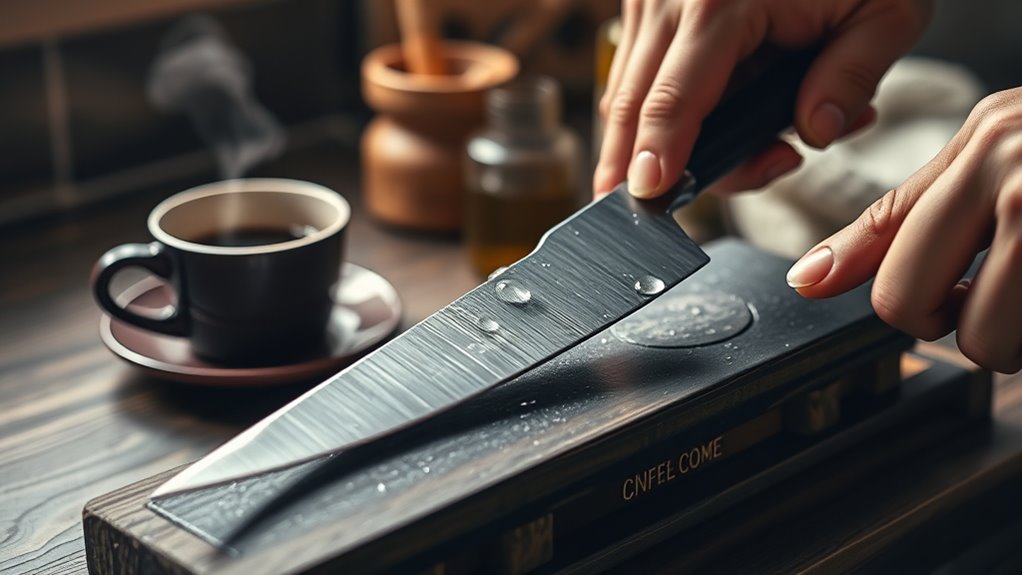
Getting started with knife sharpening doesn’t require a lot of fancy equipment—just a few essential tools can make a big difference in maintaining a sharp and safe blade. First, invest in a good set of sharpening stones; they’re essential for restoring your knife’s edge and come in various grits. Proper knife storage is also important; use a knife block or magnetic strip to prevent dulling and accidents. A honing rod can help maintain your edge between sharpenings, keeping your knife ready for use. Here’s a quick overview:
| Tool | Purpose |
|---|---|
| Sharpening stones | Restore and refine sharpness |
| Knife storage | Protect blades and ensure safety |
| Honing rod | Realign edge between sharpenings |
| Oil or water | Lubricate sharpening stones |
| Cutting board | Safe surface for sharpening |
Additionally, understanding the different types of sharpening stones can help you choose the right grit for your needs. These tools set the foundation for effective, safe knife care.
Step-by-Step Guide to Sharpening Your Kitchen Knives
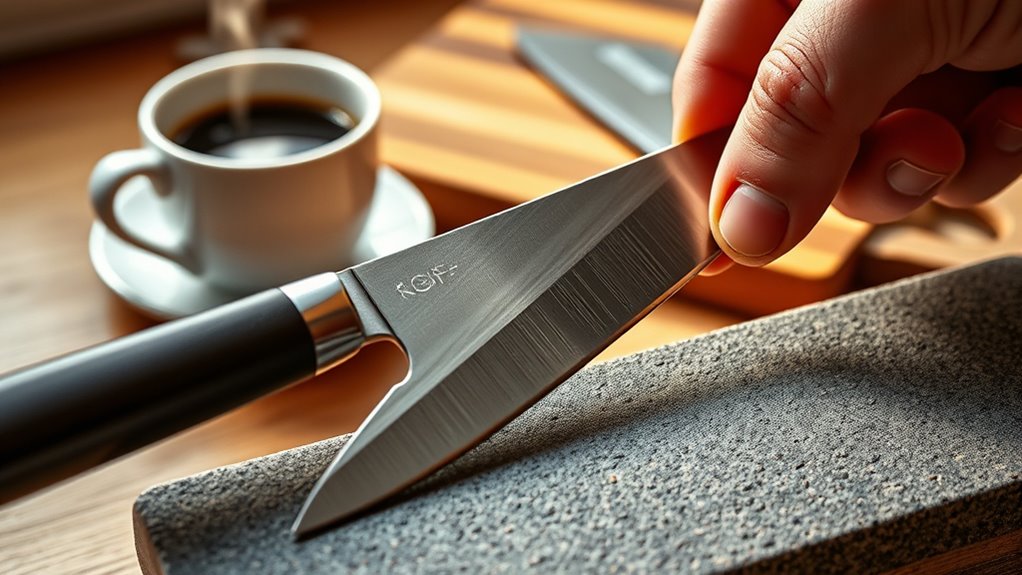
Sharpening your kitchen knives may seem intimidating at first, but with a few simple steps, you can achieve professional results. Start by understanding your knife’s blade ergonomics—knives with comfortable handles and balanced weight are easier to control. Begin with a sharpening stone or honing rod, holding the blade at a consistent angle, usually 15-20 degrees. Use light, even pressure and work across the entire edge, alternating sides. Remember, many sharpening myths suggest harder steels or more pressure make blades sharper; in reality, proper technique matters most. Regular practice improves your skill and sharpen your confidence. Keep your tools clean and dry after sharpening, and avoid rushing. With patience and consistency, you’ll keep your knives performing like new. proper technique is essential for safe and effective sharpening.
Tips for Maintaining Your Sharp Blades in Daily Use
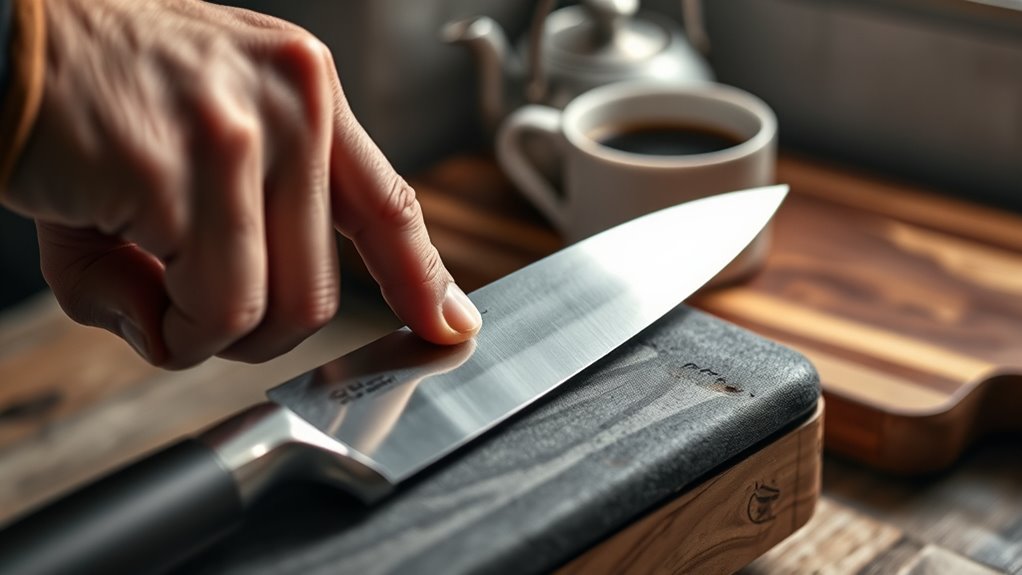
To keep your knives sharp during daily use, you need to develop simple habits that prevent dulling and damage. First, always prioritize knife safety by handling blades carefully and avoiding slips. Second, use proper storage solutions like knife blocks or magnetic strips to protect blades from knocks and dulling. Third, clean your knives immediately after use with mild soap and dry thoroughly to prevent rust and corrosion. These routines help maintain a sharp edge and extend your knife’s lifespan. Incorporating these habits into your routine can also help you avoid prohibited transactions that might damage your investment. Additionally, consistent care and smart storage not only preserve your blades but also keep you safe in the kitchen. Sharp knives make cooking safer, easier, and more enjoyable.
How to Care for Your Knives to Extend Their Lifespan
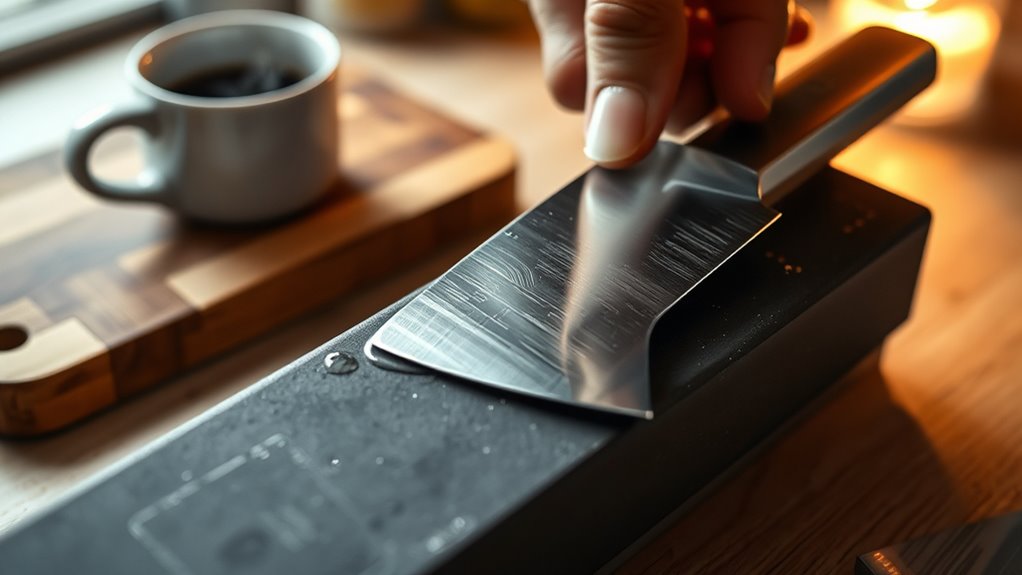
Proper care is essential if you want your knives to last for years. To do this, focus on proper knife storage and cutting board maintenance. Store your knives in a knife block, on a magnetic strip, or in a sheath to prevent dulling and damage. Avoid tossing them loosely in drawers. Regularly clean your knives with warm water and mild detergent, then dry immediately to prevent rust. Use a soft cloth for polishing. When it comes to cutting boards, keep them clean and dry, and occasionally sand or oil wooden boards to prevent cracks. Here’s a quick guide:
| Tip | Why it matters |
|---|---|
| Use a knife block or magnetic strip | Protects blades from damage |
| Don’t dishwasher your knives | Prevents dulling and corrosion |
| Clean and dry after use | Prevents rust and bacteria buildup |
| Maintain cutting boards | Keeps surfaces safe and durable |
| Regularly polish your knives | Maintains sharpness and appearance |
Additionally, choosing the right electric dirt bike can make a significant difference in your riding experience and maintenance routine.
Frequently Asked Questions
Can I Sharpen Ceramic Knives at Home Safely?
You can sharpen ceramic knives at home, but you need to prioritize ceramic safety by using the right tools and techniques. Avoid using regular sharpening stones; instead, opt for a diamond sharpening rod or a specialized ceramic sharpener. Keep your angle consistent and apply gentle pressure. If you’re unsure or uncomfortable, consider professional sharpening. Proper technique guarantees safety and maintains your ceramic knife’s sharpness effectively.
What Are Common Mistakes Beginners Make When Sharpening?
When sharpening, you often make mistakes like neglecting strop maintenance, which hampers your edge’s sharpness, or confusing honing with sharpening—honing realigns the edge, while sharpening removes metal. Focus on proper technique, and remember to strop regularly for fine-tuning. Avoid pressing too hard; gentle, consistent strokes work best. By understanding these differences, you’ll sharpen more effectively and keep your knives in top shape longer.
How Often Should I Re-Sharpen My Knives?
Think of your knives as your trusty allies—if you neglect blade maintenance, they’ll dull faster. You should sharpen your knives every 1-2 months, depending on usage. Frequent sharpening keeps your blades sharp and safe, reducing the need for aggressive cutting. Remember, consistent sharpening frequency extends your knife’s life and improves performance, so don’t wait until they’re painfully dull. Regular care guarantees your kitchen remains efficient and safe.
Is It Better to Use Manual or Electric Sharpeners?
Choosing between manual sharpening and electric versus depends on your needs. Manual sharpeners give you more control and are ideal for occasional touch-ups, while electric sharpeners are faster and perfect for frequent use. If you prefer precision and a gentle touch, go with manual; for convenience and speed, electric is better. Consider your skill level and how often you sharpen to decide which type suits you best.
How Do I Identify a Dull Knife Versus a Damaged One?
To identify a dull versus damaged knife, start with a blade inspection. If the knife struggles to cut through soft foods and needs excessive force, it’s likely dull. Look for damage signs like chips, cracks, or dents along the edge—these indicate more serious issues. A damaged blade may also feel uneven or have visible deformities, while a dull one simply loses sharpness but remains intact.
Conclusion
Now that you know the essentials, sharpening your knives becomes as natural as brewing your morning coffee. With the right tools and a little practice, you’ll keep your blades slicing smoothly and safely. Think of it like tending a garden—you nurture and care for it regularly, and it rewards you with perfect cuts every time. So, don’t be intimidated—embrace the process and enjoy a sharper, more confident cooking experience every day.
